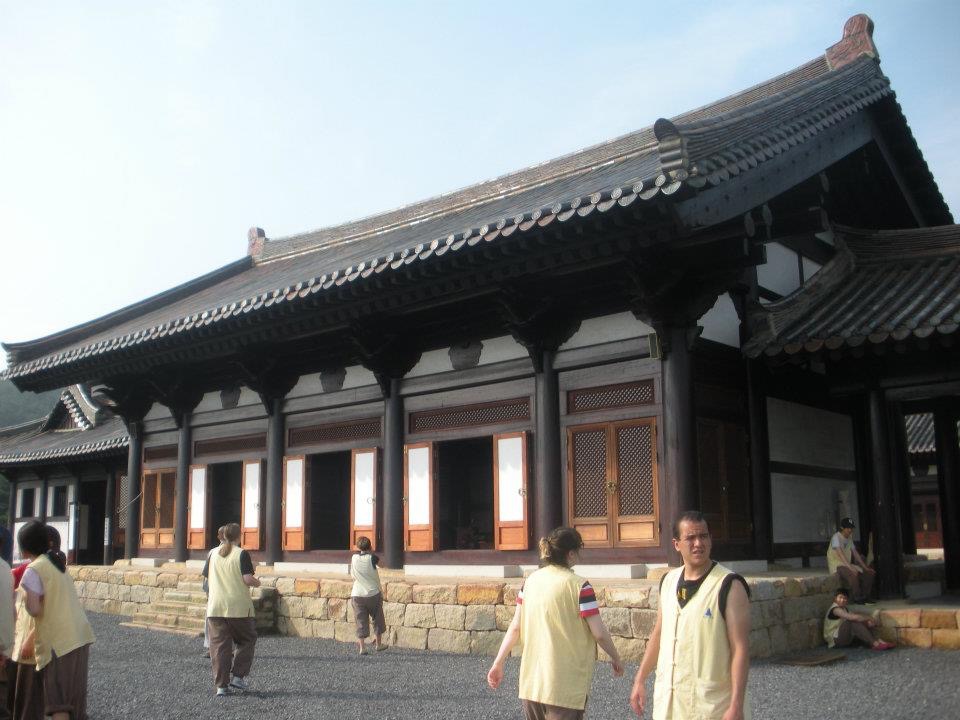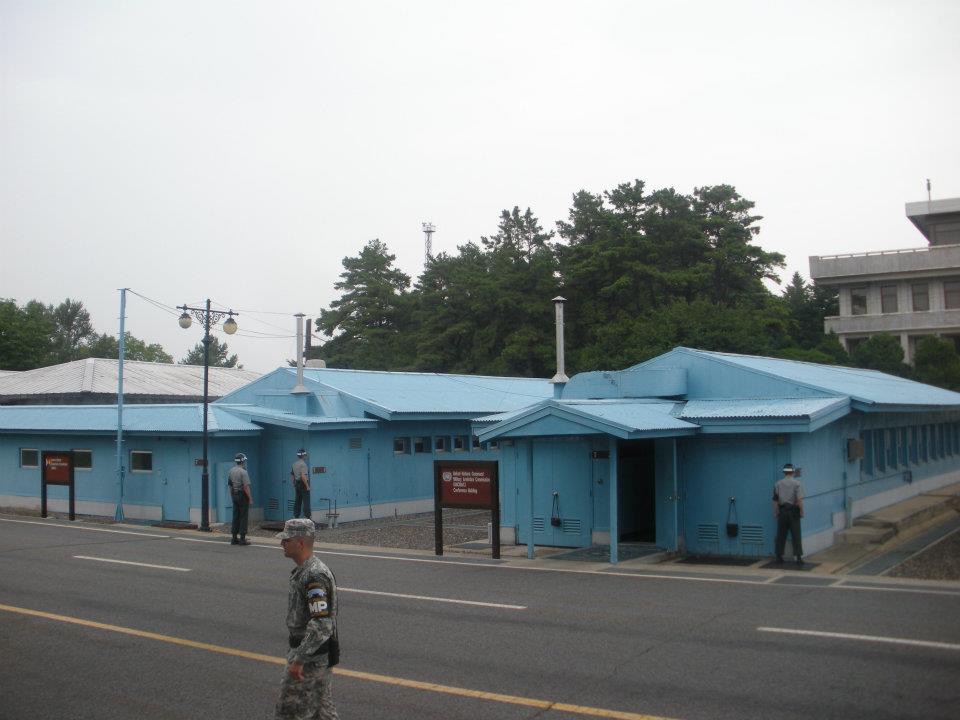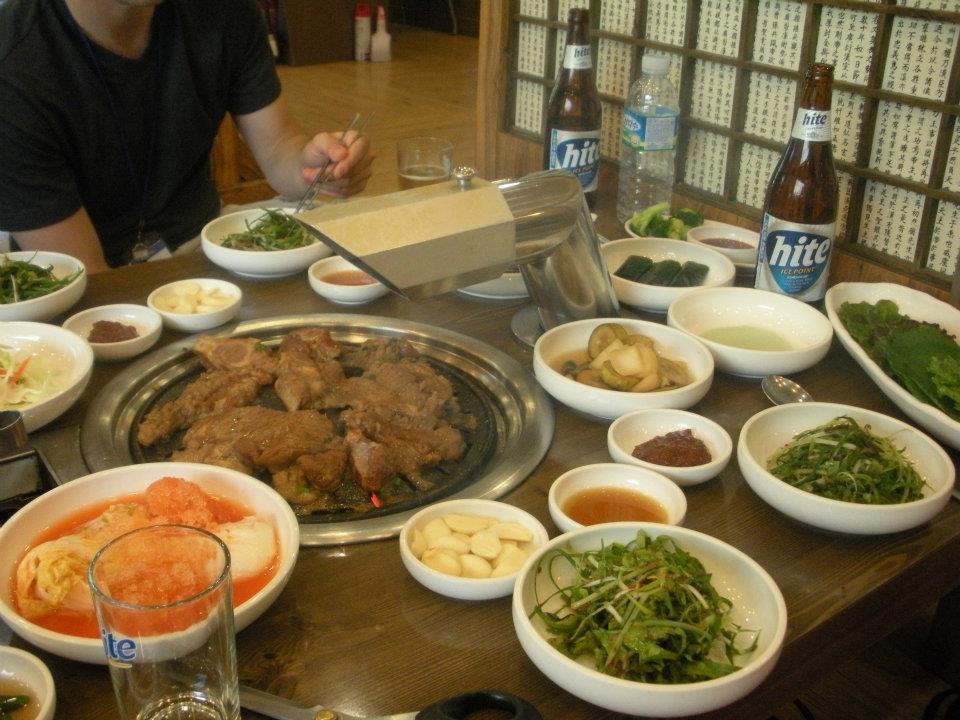15 hours to South Korea

Photo by Andrew McCutcheon
Cracking open a beer at 6:00 a.m. at Incheon airport isn’t the way I’d normally celebrate Canada Day.
But after 20 hours of travelling, sleeping in airports and nearly missing a flight in Los Angeles, our little tour group from Lethbridge, Alberta, seemed to have decided to celebrate in that manner, leaving the cold comfort of our country and arriving in one of the most powerful countries in Asia.
Our group was small: a smattering of students from the University of Lethbridge — sister school to the University of Ulsan, where we would be staying — and I’ve since gotten to know several of them well. Panicked travel tends to bond folks quickly.
There’s Felipe, the energetic Brazilian who had visited more places than all of us combined; quiet Brittany, perpetually clad in an Ascot scarf, and ever the worried first-time traveler; and Joshua, originally from Korea and a dual citizen. His ability to speak the language and read Hangul, the Korean alphabet, made our travel much less anxious.
When he revealed that he had never officially returned to South Korea to do his mandatory military service — and admitted that there was a minuscule chance the Military Police could have apprehended him at customs— our anxieties returned in spades.
We took a train. And then another. We caught sleep where we could until we met up with the welcome wagon. We took a taxi to our dormitories and met the entire 60-student travel group with whom we would be spending most of our time, comprised of all the nationalities which aided the nation during the Korean War: the United States, Germany, France and even Morocco.
Barry, an athlete from the University of Alabama, stood an easy foot taller than most everyone there and his good-natured laugh soon made friends. Jacob from Germany had already bought postcards to send to the girls back home. He hoped that they might be sweet on him when he returned.
Our study tour was to last just over month, hosted by the University of Ulsan, as a sort of diplomatic and educational mission to spread the culture and history of South Korea to places the world over. We were to have many adventures in the month to come. But at that moment, we slept a dead sleep and did our best to fix a 15-hour jet lag.
Language
Learning a new language is hard. Learning a new alphabet is harder.
However, a fellow named King Sejong didn’t appreciate that. His thought was that reading and writing should be available to the entire populace, not just to the aristocrats and the rich.
Before the Hangul, Koreans wrote in classical Chinese, but the number of characters was overwhelming. King Sejong created the Hangul in the 1400s: 28 letters, with 17 consonants and 11 vowel sounds. In modern Hangul, there are 14 consonants and 10 vowels used.
It’s a phonetic alphabet, each symbol representing a sound rather than a concept. The blocks are arranged both vertically and horizontally to make syllables and words.
This actually makes Hangul one of the easiest alphabets to memorize. If you put your mind to it without any distraction, you could know it by heart in a day.
It took our easily-distracted group of students a smidge longer.
As with any alphabet, we set out to be able to write our names first, with the proper pronunciation and format, before we had our pictures taken with our finished product, to be displayed.
Barry’s was easy. Two syllables: Bah-rie.
Andrew was a bit harder. I split my name into three syllables to make it easier to write: Ann-deh-roo.
One student participant, upon hearing that the names and pictures would be displayed, wrote his phone number underneath his name — just in case anyone wanted to give him a ring. Name withheld to protect the — mostly — innocent.
Our projects finished, we could manage to read most basic street signs in the Korean alphabet. Not that we had any clue what they meant: we still had the rest of the language to learn.
It was an accomplishment, nonetheless.
Bus Trip
We headed out of Ulsan then, and we traveled by bus more often than not.
Korea is small, compared to what we’re used to. The entire nation could fit into Alberta.
Six times over.
With Hangul under our belts, we hopped onto a bus, Barry, myself, Felipe, Brittany, and others. We didn’t take Joshua that time. We planned on making our own way to downtown Ulsan to get a delicious seafood dinner.
We hit transit. We talked, got to know one another, played games in the back of the bus. We received a few stares before we realized: the bus was deathly silent except for all of us loud tourists. Opps; it’s best not to annoy folks coming home from work.
We waited for a while till the bus emptied, and the situation was no longer shoulder-to-shoulder.
Outside, it became a little darker as well.
And then we ended at the terminal stop. We were not in downtown Ulsan. We looked out and saw the ocean. In fact, we had not started anywhere near the ocean.
This is what the kids call a “big yikes.”
But we were still hungry.
We found a nearby restaurant and started to play charades with the menu and the hostess. Thankfully, the restaurant was nearly empty, and she seemed to be good-natured about our confusion. An elementary-school girl from one table over stopped by and translated in fairly good English, helping us before we’d accidentally ordered enough food for an army. She spoke better English than I’ve ever spoken French in my entire life.
The bus ride back was quiet, as we had full stomachs and a good story under our belts. Sometimes it’s nice to get lost.
The Demilitarized Zone
In total, 516 Canadians died during the Korean War, part of the 996,937 who lost their lives during the conflict in the overall United Nations’ force.
It was the first major conflict following World War Two that would test the potential of the UN, and the first of many East versus West conflicts during the latter half of the 20th century.
When we visited the Joint Security Area (JSA) of the Demilitarized Zone (DMZ) between North and South Korea, there were no jokes on the bus. Barry didn’t tell stories or do one of his silly voices, and even Felipe managed to put on a solemn air in contrast to his usually fidgety demeanour.
The DMZ is roughly 250 kilometres long and at its widest, four kilometres. At the JSA, where peace talks occur in a handful of light-blue buildings, the colour of the UN, it’s barely a foot across. It was established in 1953 following the Korean War and acts as a barrier and de facto border between the once unified countries.
Incidents and incursions have happened in this area and everyone is on guard. Rules were established by the American military officer who conducted our tour: only take photos when allowed; no gesturing across the border, lest you feature in North Korean propaganda; and do not take a single step out of line.
We took photos silently to document our journey and remained deathly quiet. We heard the story of when a DEFCON 3 readiness alert was declared following what was supposed to be a simple operation to cut down a tree in 1976 near the JSA. We followed the military officer’s every instruction.

At the end of the tour, we visited the JSA gift shop.
This is the part of the story that people tend to focus on: almost as if we were touring a historical museum or art gallery and not a heavily fortified international border, we finished at a gift shop. All proceeds went to humanitarian efforts for the North.
Some purchased North Korean currency replicas or flags. I walked away with a bottle of North Korean blueberry whiskey. The military officer posed for photos and our smiles and jokes returned with our breath, which had seemingly been held during the entire hour-long event.
We exhaled later, however, at the United Nations cemetery in Busan where Canadians and many others were laid to their final rest. We did not joke. We did not smile.
Temple stay
We took a bus to a Buddhist temple. Our bus had a built-in Karaoke system, but it felt slightly wrong to sing Karaoke at this time.
When we arrived, it was sweltering, but we were still asked to wear baggy yellow trousers and vests, as a way for both the men and women of the tour group to cover up slightly. We complied even though the temperatures were pushing the high 30s and the humidity was like a full sauna.
Even Felipe commented on the heat, despite him seeming unflappable through every summer storm and heatwave that we’d experienced.
Our first order of business was a hike to where ancient stone records are kept. The historical significance excited me. The hike did not.
We had a very plain meal that evening: rice, tea, vegetables and tofu. It was vegetarian, as are most Buddhists, and every morsel had to be consumed. This included rinsing out our trays and drinking the water to get every individual grain of rice. Brittany gagged and held her nose, and none of us held it against her.
That evening, when it cooled down, we were brought to a tiered pagoda shrine surrounded by cold grass and dirt. We removed our footwear and were asked to do a barefoot walk around the small pagoda. The only catch was that it was supposed to take us an hour.
Confusion occurred. Was something lost in translation? The fidgety Felipe looked worried. A full hour?
It ended up by being one of the most memorable experiences we had while in the country.
Every single step was maybe a millimetre, and quickly boredom set in. Soon afterwards, boredom gave way to a whole host of new, unfamiliar feelings: taking in every tactile sense repeatedly until this quiet pagoda walk turned into a feast of feeling and touch and temperature. The entire hour seemed to fly by in a flash of rhythmic breathing and the quiet crunch of grass.
Ever since then, whether it’s work or family, or any host of frustrating reasons to feel upset or annoyed, I take off my shoes and put my feet on the cold dirt.
It’s the best souvenir I’ve ever got.
And it didn’t cost me a penny.
The food
Kimchi, by all accounts, should be foul.
Cabbage with an array of spices, pickled and fermented for long stretches underground in earthenware pots. It comes out looking like a stringy, red mess with a smell that could knock out ten mules in as many paces.
But it is delicious. Like sauerkraut, but hearty and thick, with a satisfying crunch. It’s used as a side dish, fried with rice, an addition to stews and soups, and a thousand other different ways I’ve yet to try. Kimchi-specific refrigerators are not uncommon.
Salty and spicy is a good way to describe much of Korean cuisine. I was partial to bulgogi stew: piled high with stewed beef, translucent wheat noodles, a smattering of vegetables, tofu and long, stringy enoki mushrooms. It warms the chest like a bubble bath for the soul.
Cuisine, especially eating out, is a shared experience. Those lucky enough to have a Korean barbeque on this side of the continent, know only a morsel of the flavours available. Pork belly and marbled beef, cooked to perfection on a gas grill at your table where everyone takes a turn ensuring that their meat is to their taste. There are assorted side dishes, sauces and vegetables — and when the meat is done, it’s scooped up with a lettuce leaf, piled on with chilli paste or a bulb of freshly broiled garlic, and downed in a single bite.
Many meals were shared with groups at low tables covered with dozens of dishes and meats, pouring Korean beer into plastic cups from a frosted bottle for friends before finally helping yourself. A toast to good health and good luck was made before stories of the day and tales of that-time-we-got-lost were recounted with laughter. Everyone shared smiles all round.
A particular meal of note followed me while heading out with some Korean students who wanted to practice their English. Fried chicken and beer sounded more Western than Korean, but it was at their invitation.
I sat with them, my small vocabulary of Korean offset by their rigorous study of English. We discussed the differences in our upbringings and schooling, over some deliciously decadent and savoury chicken — and there was more than one round of light, Korean lager.
Still a might peckish, I asked their help in ordering “something spicy, spicy enough for someone from Korea.” They looked at each other in worry before they looked back at me, but I nod with a solemn seriousness which only belongs to either the very ignorant or the very brave.
I, it would seem, am both. The first bite was like a wildfire after a dry, Alberta summer. I was in literal, physical pain. I didn’t even taste the chicken, nor did I think I’d be able to taste anything for at least 48 hours.
I choked down the first bite and looked over to the plate with several more morsels left, and ordered another round. I may be ignorant, but at least I am brave.

Goodbyes
We left for the airport with waves, following our “graduation ceremony.” Barry won a small plaque for being the most enthusiastic of our group, and Brittany replaced her Ascot with one of several scarves she haggled for in the underground nighttime markets of Seoul. She breathlessly recounted the story to anyone who would listen.
Felipe was taking advantage of our location to do a quick hop of a flight to Japan, then off to Taiwan before the fall semester started. Jacob wrote and sent his final postcard. He was likely to beat it home.
Joshua was staying in Korea for a little longer, heading north. He was going to visit family he hadn’t met in his entire life. His luggage was piled high with gifts.
The way home was to be another 15 hours, but sleep came more easily. I ordered the inflight meal in proud, broken Korean. I took off my shoes and stretched as best I could. I dreamed of bare feet walking on the cool, dark dirt.
